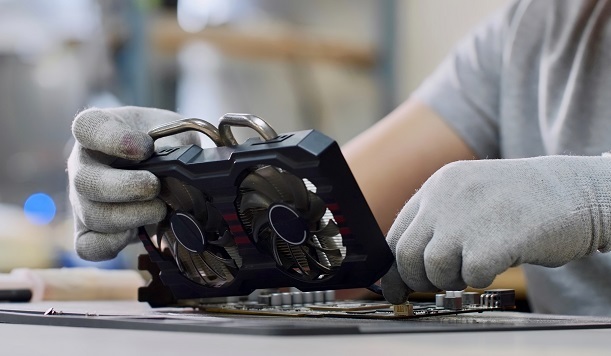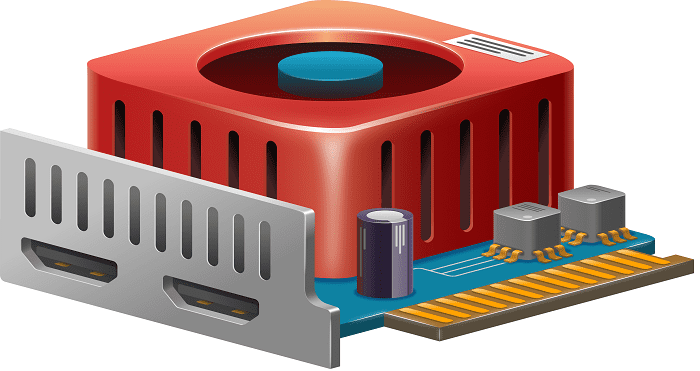
 Data Structure
Data Structure Networking
Networking RDBMS
RDBMS Operating System
Operating System Java
Java MS Excel
MS Excel iOS
iOS HTML
HTML CSS
CSS Android
Android Python
Python C Programming
C Programming C++
C++ C#
C# MongoDB
MongoDB MySQL
MySQL Javascript
Javascript PHP
PHP
- Selected Reading
- UPSC IAS Exams Notes
- Developer's Best Practices
- Questions and Answers
- Effective Resume Writing
- HR Interview Questions
- Computer Glossary
- Who is Who
What is the full form of GPU?
Introduction
Graphics Processing Unit (GPU) is an electrical part or chip created primarily for rendering and modifying visual data, such as photos, movies, and 3D graphics. The difficult mathematical operations needed for rendering images, including as geometry changes, texture mapping, lighting effects, and pixel shading, are performed to a high degree of proficiency by this specialised processor.

GPUs are frequently found in gadgets like PCs, game consoles, and cell phones, where they play a key role in producing top-notch visuals and facilitating fluid visual experiences. Due to its parallel design and computational efficiency, GPUs are also widely employed for non-graphic activities that call for parallel processing, such as machine learning and scientific calculations.
History and Development of GPU
The 1980s were a significant period in the history and development of GPUs. Initially, the Central Processing Unit (CPU) was responsible for all graphical operations in computer graphics. However, as the requirement for increasingly complex graphics grew, it became clear that specialised hardware was required to speed up graphical operations.
The GeForce 256, the first GPU created solely to handle 3D graphics, was released by NVIDIA in 1999. This GPU's customizable shading features revolutionised the video game and computer graphics industries by greatly enhancing rendering speed. Later generations of GPUs continued to push the limits of graphics processing power in its wake.
The Radeon series of GPUs were released by ATI Technologies, which is now a part of AMD, at around the same time as NVIDIA joined the GPU market.
Early in the new millennium, GPUs began to advance beyond graphics processing. The parallel design of GPUs might be used for general-purpose computing activities, researchers and developers recognized. Due to this, General-Purpose GPU (GPGPU) programming emerged, where GPUs were used for activities like machine learning, data processing, and scientific simulations.
In 2007, NVIDIA unveiled CUDA (Compute Unified Device Architecture), a parallel computing platform and programming style that empowered programmers to use GPUs for tasks other than graphics. This increased the usage of GPUs for general-purpose computing and created new opportunities in disciplines like deep learning and artificial intelligence.
GPUs have improved in terms of performance and functionality throughout time. They now play a crucial role in many different fields, including gaming, professional graphics, academic research, and artificial intelligence. Leading GPU developers include NVIDIA, AMD, and Intel. These companies are continually inventing and introducing newer generations of GPUs with enhanced performance, increased efficiency, and unique features designed for certain applications.
Applications of GPU
GPUs are used for a variety of tasks in addition to graphics processing. A few of the major applications for GPUs are as follows
Gaming The rendering of realistic and lifelike images using GPUs in video games allows for high-resolution textures, intricate lighting effects, and fluid frame rates.
Computer-Aided Design (CAD) and Modelling In fields including architecture, engineering, product design, and animation, GPUs speed up 3D modelling, rendering, and simulation activities, enabling quicker and more accurate representations.
Data Science and Machine Learning GPUs are now essential for speeding up data processing and developing sophisticated machine learning models. They are perfect for applications like audio and image identification, natural language processing, and recommendation systems because their parallel processing capabilities allow for speedier computations.
Scientific Research and Simulation Across a wide range of scientific fields, including physics, chemistry, biology, and climate modelling, GPUs are used in scientific simulations and computer research. They let academics analyse enormous datasets and run intricate simulations, accelerating the pace and effectiveness of scientific study.
Cryptocurrency Mining Bitcoin and Ethereum are two cryptocurrencies that are often mined using GPUs. Their powerful computing capabilities are ideal for handling the challenging computations needed for bitcoin mining.
Virtual Reality (VR) and Augmented Reality (AR) In order to create immersive virtual and augmented reality experiences, GPUs are essential. For VR and augmented reality applications, they manage the real-time rendering of 3D scenes and objects, delivering fluid and lifelike images.
These are just a handful of the numerous uses for GPUs. GPUs are now necessary in a variety of businesses that demand high-performance computing and visualisation capabilities due to the parallel processing capacity and efficient calculation they offer.
Types of GPU
There are primarily two types of GPUs
Integrated Graphics Processing Units (iGPUs) GPUs that are incorporated onto the same chip as the CPU are commonly found in AMD and Intel CPUs. These GPUs offer a low to moderate degree of performance and are meant to handle simple visual jobs. They are frequently discovered in laptops, workstations, and low-cost computing equipment. iGPUs are appropriate for routine operations like web browsing, playing back multimedia, and light gaming.

Discrete Graphics Processing Units (dGPUs Discrete GPUs are independent hardware elements used only for graphics processing. They are independent cards that attach to the motherboard of the computer, often through a PCI Express slot. Compared to integrated GPUs, dGPUs are more potent and provide better performance. They are frequently found in workstations, high- performance systems, and gaming PCs that need extensive graphics processing. NVIDIA and AMD are two well-known producers of discrete GPUs.
It's important to note that each type of GPU has a variety of models and generations available. Periodically, manufacturers produce new versions with enhanced features, performance, and power efficiency. These models may differ in terms of their functionalities, memory holdings, clock rates, and unique features made for certain uses like gaming, content production, or expert graphics work.
Conclusion
In order to improve graphics performance, GPUs are frequently found in computers, game consoles, and mobile devices. They are extremely parallel computers with the power to carry out the difficult mathematical operations necessary for creating realistic 3D visuals. Due to their tremendous processing power and efficiency, GPUs are also used for general-purpose computing applications like machine learning and scientific simulations.
FAQs
Q1. How does a GPU differ from a CPU?
Ans: A CPU is a general-purpose processor in charge of running the whole system and handling a broad variety of activities, whereas a GPU is focused on graphics processing duties and excels at parallel processing.
Q2. What are the advantages of using a GPU for non-graphical tasks?
Ans: GPUs provide several benefits, including strong parallel processing capacity that speeds up computations, the ability to execute complicated calculations more quickly, and enhanced performance for work like data processing, scientific simulations, and machine learning.
Q3. Can integrated graphics (iGPU) replace a discrete GPU (dGPU)?
Ans: Integrated graphics (iGPU) are adequate for simple graphical activities but fall short of discrete GPUs (dGPU) in terms of performance and capability. In contrast to dGPUs, which are advised for demanding applications like gaming, professional graphics work, and compute-intensive jobs, iGPUs are enough for daily operations.

